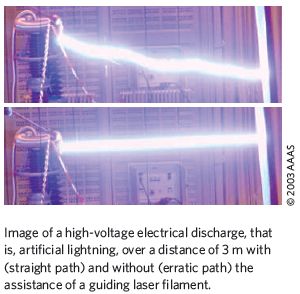I haven’t done a Photonics Briefs for a while, and I can’t promise to do one for the next while, but this latest Nature Photonics issue had an interview that’s too cool not to share.
Today’s article is entitled “Lightning Control By Lasers.”
The goal of these projects is to design essentially next-gen lightning rods that could shoot lasers at thunderclouds which would then cause a lightning strike at the laser source (which would be a grounding rod for the discharge).
To create a discharge like this, the laser utilizes short, intense pulses to ionize air (similar to what we use in our lab), which would then act as the conduit for the lightning to follow.
The laser they want to build is also pretty sick.
While it has the same wavelength (800nm) and pulse lengths (70fs – 2ps) as our lab system it’s power is over 100 times greater than the new half-million dollar system that was just installed (and is nearly 1000 times greater than the older laser system). Their laser will put 350 mJ into every pulse that it fires, giving it a peak power of 5 TW (or 5×1012 Watts, equivalent to a billion microwave ovens running at once) at 10 Hz rep rate (one pulse every tenth of a second).
Basically, do not stand in the way of this laser.
And finally, because this needs a picture:

On the top is normal electrical discharge (what a small lightning strike would look like), and on the bottom is the laser guided lightning.
This just screams for an evil mad scientist and a plot to take over the world.
From: “Lightning control by lasers,” Nature Photonics, Vol. 3, no. 3, pp. 120-121 (2009).
How does the energy required to ionize the path compare to the energy recovered from the lightning? Can this be a net gain?
An interesting question. I think that there’s not a lot of current in the average lightning strike (I’m not sure about this), and this is definitely an extremely high powered laser system. I think even if you could recover the energy from the lightning (which comes in such a short period of time that it creates its own difficulties), that you’d still get less than the amount required to keep the laser running.